2020 BMW R NineT Vs Triumph Speed Twin
Timeless Twins Retro Comparo
Is Retro still booming? It was when BMW built its first R nineT in 2013, a bike that was so successful they’ve built like five more versions in the ensuing years. In fact, there are so many nineT’s it’s hard to keep them straight. We put the R nineT Pure in last place in 2017, when we shot it out against the now-defunct Honda CB1100EX and Triumph Bonneville T120 Black here. But in 2014, we rated the standard R nineT first, in a comparison involving the also-defunct CB1100 regular and Moto Guzzi Griso 8V.
BMW will still sell you an R nineT Pure stripper for $9,995, but that’s not really what you want. The regular R nineT we’ve got here starts at $15,495 for 2020, and the Option 719 Black Storm Vintage Metallic paint on this one tacks on another $950. On the website, BMW sneaks in another $350 for the “Aluminum Sanded Weld fuel tank,” even though that’s what the bike comes with. Pretty soon you’re looking at $17,290. Gulp.
And Triumph started building Speed Twins in 1938, with a slight respite in production beginning in 1966 that lasted until 2019. To the BMW’s 1170cc air-/oil-cooled Boxer twin, the Triumph counters with an updated and lightened version of the Hi-Power 1200cc 270-degree crank parallel-Twin that was available previously only in the Thruxton. The original Speed Twin was the bike that saved Triumph from the dustbin of history, all the books agree, and you know the new Triumph was saving that name for something special. Brasfield came back from the launch last year so impressed he bought a KTM Duke 790.
Retro Standard
How do you test for retro anyway? Retro is really in the eye of the beholder, and in fact, both of these bikes retain plenty of functionality. Weren’t all ’60s bikes standards? So when it’s time to test we put them through the full MO gamut – even if many buyers are only going to ride them to cars and coffee meetups on Sunday mornings.
For high-speed cruising, ie, 85-ish mph for the long freeway stretches lots of us have to do to get to the fun roads or to work, neither of these bikes is exactly ideal, since neither one wears even a fly screen. The BMW, though, has a lower handlebar that cants its rider a bit more into the wind, and that makes all the difference. With a snuggish jacket and a good helmet on a warm day, you’ll never miss the windshield; the only sad part is that neither bike comes with cruise control.
The Beemer’s footpegs are in just the right spot for 5’8” people, the air-/oil-cooled cylinders jutting out either side don’t produce any noticeable heat, the seat’s nice and broad behind the big, 4.8-gallon tank – and mainly the suspension on this 2020 R nineT is highly bump-absorbent and supple: A big part of the BMW’s price premium is in its fully adjustable inverted fork mit 46mm tubes, and its rebound-adjustable linkage-mounted rear shock, which also includes a handy manual preload knob. Some lower-spec nineT’s we’ve sampled over the years haven’t been the smoothest highway cruisers. This one is. All the bugs are worked out of that oilhead boxer, which debuted in 1993; 5000 rpm at 85 mph is a bit short-geared for that motor, but the nineT springs out of the blocks from just about any speed as a result. Good vibrations are sometimes felt through its grips but never annoying ones. At 85 mph, the flat boxer drone sounds like flying over the Alps in a Fokke-Wulf whatever, which you wouldn’t be surprised to learn BMW built engines for.
The BMW’s seat’s a bit lower than the Triumph’s, its wheelbase is two inches longer, it comes with a steering damper – and the overall feel at speed is that you’re straddling a very stable, unstoppable force.
The Speed Twin can’t quite match the BMW for 80-mph cruising comfort, mostly because of its more upright ergonomics, but also because its old-school 41mm fork and twin shocks lack the smoother damping of the BMW’s pieces over bumps. With no steering damper, it also doesn’t feel as planted over rain grooves and sketchy pavement.
The narrow, 3.8-gallon fuel tank that looked cool on the cafe racer Thruxton looks and feels a little small between the knees in this application, and the footpegs that got moved forward and lower compared to the Thruxton still feel a bit too far rearward on the Speed Twin, resulting in a slightly knock-kneed riding position when you’re sitting up front. Luckily, the seat is flat, and if you scoot yourself rearward upon it and lean into the handlebar, it all comes together well enough at cruising speed. Also, that skinny gas tank seems to provide a perfect pathway for hot air from the engine bay to waft up inside your thighs, which is nice on cool days but not at all cool on hot ones. It’s never as hot as an early Indian Chieftain, but it’s definitely warm. And it’s really not cool to put such a small tank on a bike that gets 41 mpg.
That 1200 cc parallel Twin is slightly vibey through the grips on our test unit at 80 mph and 4500 rpm, but by 85 and 4700 she’s really smoothing out, so there’s your excuse, officer. Both these bikes are right in their power wheelhouses at that speed: Rolling on the Triumph from 85 blasts you regally past the Ton very quickly, past 110 just a tick later, 120… power won’t be a problem. If there’s a governor up there, I didn’t hit it. However, people who were incensed that Buell XB9s only revved to 7000 rpm may also be upset that so does the Speed Twin; its best work is behind it at 6600 rpm.
Creature comforts
Ya ain’t got any to speak of. Be happy it’s always warm and dry here. The BMW’s got heated grips, which are optional on the Triumph. There’s a 12v outlet somewhere on the BMW, also optional on the Triumph. Both bikes get ABS and basic traction control.
Ride Like a Maniac
It’s definitely doable on both bikes. Troy gives both an 8.0 on the MO Scorecard in the Handling category, which is fair enough: The boxer twin is a fun engine, and its application in the R nineT is just another example of why. There’s loads of power, though its happy place is north of 3500 rpm.
It’s a little weird that the boxer has a single-plate clutch, like a manual transmission car (does anyone here besides me still drive a stick shift car these days?). I guess in practical terms it really doesn’t matter, but most other bikes use multiple plates soaked in oil.
The R9T is longer and steers a little slower than the Triumph, but I think it’s better damped. You especially feel this on the freeway, as the ride is more plush and compliant – and it really pays off on bumpy backroads, too.
To me the biggest difference is the brakes. The 320mm discs and radial calipers are a lot better than the Triumph’s smaller discs and old-school calipers.
He’s right about the BMW’s superior stopping power, but I had to rate the Triumph as the better backroad burner. Its 305mm discs have plenty of power for street use. And the fact that the Triumph is shorter of trail, two inches shorter in the wheelbase, with a higher center of gravity and a skinnier rear tire – all make it a bit quicker in changing directions than the BMW. The Triumph’s cheaper suspension doesn’t soak up bumps as well as the BMW, but it does keep the bike in line and even-keeled when you commence flogging it rental-mule style. Also, the Triumph’s six-speed gearbox and chain drive let you row the gears a smidge more uninterruptedly than the boxer’s shaft drive.
If the Triumph’s Sport mode is too aggressive for your taste, it’s easy to flip it into Road, where its power delivery is still immediate and impressive from just off idle. The BMW has zero fueling issues.
In those tight Malibu canyon roads, the Triumph’s sit-up ergos are just right. I think if the BMW were mine, I’d have to saw an inch off each end of the handlebar. It feels wide like you’re about to drag a knuckle, a bit too stretched out for optimal shifting from side to side. A minor nitpick for sure, and in spite of all the Speed Twin’s superior chassis specs and lighter weight, the BMW hangs right with it; it just needs a bit more effort from the rider. On a faster, more open road, the Beemer feels like it might use its extra horsepower and superior suspension to clear off from the Triumph.
Tangibles
We’re suckers for shiny objects, and the BMW has that stuff covered, with lots of sweet details in addition to its colorful fork adjusters and knobs, rondels, aluminum brackets, alloy tank and vintage paint. Then again, the BMW does cost nearly $4k more than the Triumph, which comes with standard fork gaiters!
Though we expected the Speed Twin to be a bit more “special” given its historic name, Triumph is in fact honoring the 1938 original by keeping it simple, as that first parallel Twin was also lashed together from existing components in a last-ditch effort to keep the company afloat. And if this plain-Jane Speed Twin is too pedestrian for your tastes, you know there’s got to be an S version right around the corner. Or an R?
Intangibles
Some have observed that the BMW, with its handpainted 21s, looks like it belongs on back of a crash truck, but that’s very un-woke and looks are so subjective. Pixels don’t do either bike justice. In the metal, they’re both swell looking motorcycles – the BMW more for its interesting components, the Triumph more for its big-picture modern interpretation of that classic look, especially in Korosi Red. Both are direct descendants of motorcycles that actually deserve application of the overused word “iconic,” even if Triumph was brought back from the dead. It’s still that classic matchup that never gets old: England vs Germany. To keep the historical perspective, maybe we’ll compare them to a Kawasaki Z900RS 30 years from now.
Troy says: Both bikes are cool, retro-inspired throwbacks with modern tech. Like fuel injection. That’s nice. Honestly, I’d be happy with either one, as I like how both are styled. Their engine characteristics are very different, but both are very cool. Character is hard to define on spec sheets, but all you have to do is ride either one of these to experience the definition for yourself. They make the right noises, the right vibrations, and have quirks that are endearing, not annoying. The Triumph is a few thousand bucks cheaper. With an extra three or four grand to use, I bet I could trick out the Triumph a lot and make it better than the BMW. But if you just want to hop on and ride without having to worry about improving anything, or lubing a chain, the BMW is the way to go. Unless, of course, you like the way the Triumph looks better. There really is no wrong choice here.
In the end, this one was a real squeaker, with Troyboy and myself picking the BMW by the narrowest of margins, and mostly because the extra $4k it costs buys it better suspension. The Triumph is actually a better sportbike most of the time, but the BMW is nearly as good, and it’s better at everything else – though either one could easily be an everyday motorcycle. At the bottom of the Scorecard, it wound up 86.82% BMW to 86.14% Triumph. This battle is over. The war, thank God, rages on!
BMW R nineT
+ Highs
- A great idea for 97 years now
- Sweet suspension = excellent comfort
- Way low maintenance, fire and forget
– Sighs
- Vaguely Frankensteinian looks
- Can’t find the cruise control because there isn’t any
- My magnetic tank bag won’t stick to aluminum
Triumph Speed Twin
+ Highs
- Great, burly-sounding 270-degree twin
- Frisky backroad performer
- Excellent to-the-manor-born retro style
– Sighs
- A little more top end wouldn’t be a bad thing
- Downspec components hurt ogleability more than performance
- 3.8-gallon tank = no go for many riders
John’s In Gear

Helmet: Shoei Neotec 2 Splicer $799
- Jacket: Dainese Street Rider Perf (discontinued)
- Gloves: Dainese 4 Stroke EVO (discontinued)
- Jeans: Trilobite Parado Elastic Men’s Jeans $175
Boots: Sidi Arcadia Tex $170
Troy’s In Gear

Helmet: HJC RPHA 90 Tanisk $404
- Jacket: Alpinestars Oscar Charlie Leather Jacket $550
- Airbag: Alpinestars Tech-Air 5 System $700
- Pants: Alpinestars Crank Riding Jeans $198
- Gloves: Alpinestars SP-2 v2 Gloves $140
Boots: Alpinestars Oscar Rayburn Riding Shoes $250
Scorecard | BMW R nineT | Triumph Speed Twin |
|---|---|---|
Price | 73.5% | 100% |
Weight | 97.6% | 100% |
lb/hp | 100% | 94.2% |
lb/lb-ft | 95.0% | 100% |
Total Objective Scores | 89.5% | 99.0% |
Engine | 90.0% | 88.8% |
Transmission/Clutch | 77.5% | 82.5% |
Handling | 80.0% | 83.8% |
Brakes | 90.0% | 80.0% |
Suspension | 90.0% | 72.5% |
Technologies | 75.0% | 75.0% |
Instruments | 85.0% | 77.5% |
Ergonomics/Comfort | 85.0% | 85.0% |
91.3% | 87.5% | |
Cool Factor | 90.0 | 86.3% |
Grin Factor | 90.0% | 87.5% |
John’s Subjective Scores | 86.9% | 83.3% |
Troy’s Subjective Scores | 85.4% | 82.5% |
Overall Score | 86.8% | 86.1% |
Specifications | BMW R nineT | Triumph Speed Twin |
|---|---|---|
| MSRP | $17,290 | $12,999 |
| Engine Type | 1170cc horizontally opposed air-/oil-cooled Boxer Twin; DOHC, 4 valves/cylinder | 1200cc liquid-cooled parallel-Twin; SOHC, 4 valves/cylinder, 270-degree crankshaft |
| Bore and Stroke | 101.0 x 73.0mm | 97.6 x 80.0mm |
| Compression Ratio | 12.0:1 | 11.0:1 |
| Rear Wheel Horsepower | 93.6 at 7700 rpm | 86.0 at 6600 rpm |
| lb/hp | 5.24 | 5.56 |
| Torque | 71.8 lb-ft at 5000 rpm | 73.8 lb-ft at 4100 rpm |
| lb/torque | 6.82 | 6.48 |
| Transmission | 6-speed | 6-speed |
| Final Drive | Shaft | Chain |
| Front Suspension | 46mm fork; adjustable for spring preload, rebound and compression damping, 4.7 in. travel | 41mm cartridge telescopic fork; 4.7 in. travel |
| Rear Suspension | Single shock; adjustable for spring preload, rebound damping, 4.7 inches wheel travel | Twin shocks; spring preload adjustable; 4.7 in. travel |
| Front Brake | Dual 320mm disc, four-piston calipers, ABS | Dual 305mm disc, four-piston calipers, ABS |
| Rear Brake | 265mm disc, two-piston caliper, ABS | 220mm disc, two-piston caliper, ABS |
| Front Tire | 120/70 ZR 17 | 120/70 ZR17 |
| Rear Tire | 180/55 ZR 17 | 160/60 ZR17 |
| Rake/Trail | 26.8°/4.2 in (108mm) | 22.8°/3.68 in. (93.5mm) |
| Wheelbase | 58.5 in (1487mm) | 56.3 in (1430mm) |
| Seat Height | 31.7 in (standard seat) | 31.8 in |
| Curb Weight, MO scales | 490 lb. | 478 lb. |
| Fuel Capacity | 4.8 gal | 3.8 gal |
| MO Observed Fuel Mileage | 42 mpg | 41 mpg |
Become a Motorcycle.com insider. Get the latest motorcycle news first by subscribing to our newsletter here.
We are committed to finding, researching, and recommending the best products. We earn commissions from purchases you make using the retail links in our product reviews. Learn more about how this works.
More by John Burns






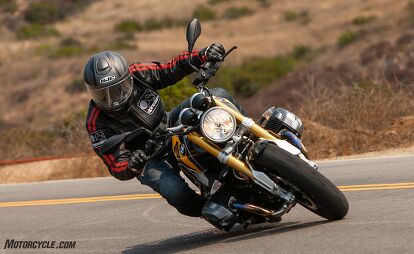

























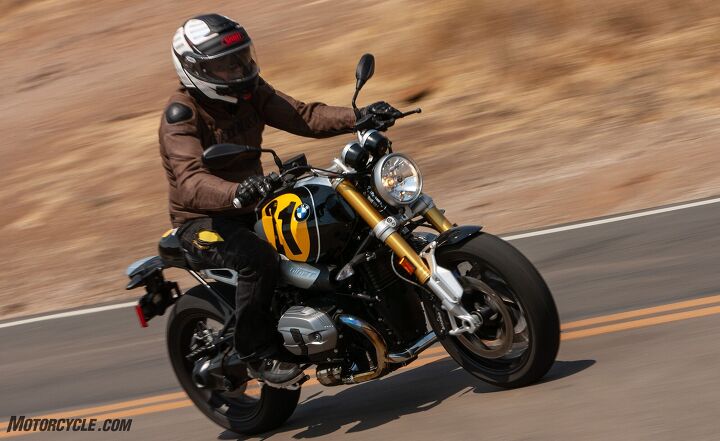
























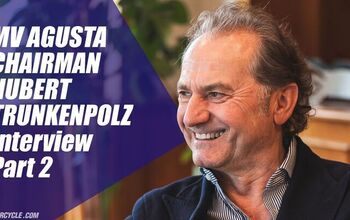




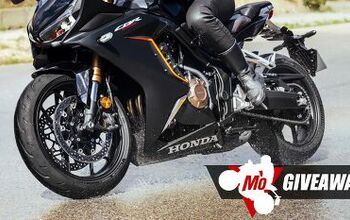






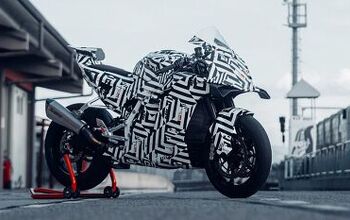
Comments
Join the conversation
i will gladly take either. Even with the number on the tank.
It's a no-brainer... Triumph for the win! With such a huge price difference you could re-fork & re-shock the Brit bike and make a better bike hands down! And tell me again why you would build a bike where your entire valve train doubles as crash bars on your bike?? One of the most laughable things about the boxer twin design.